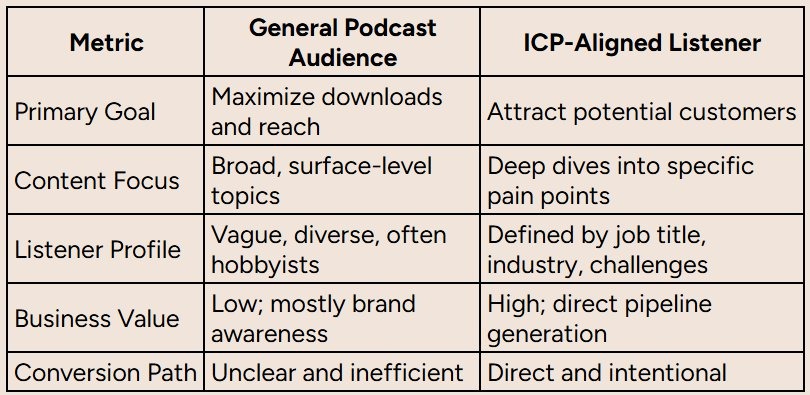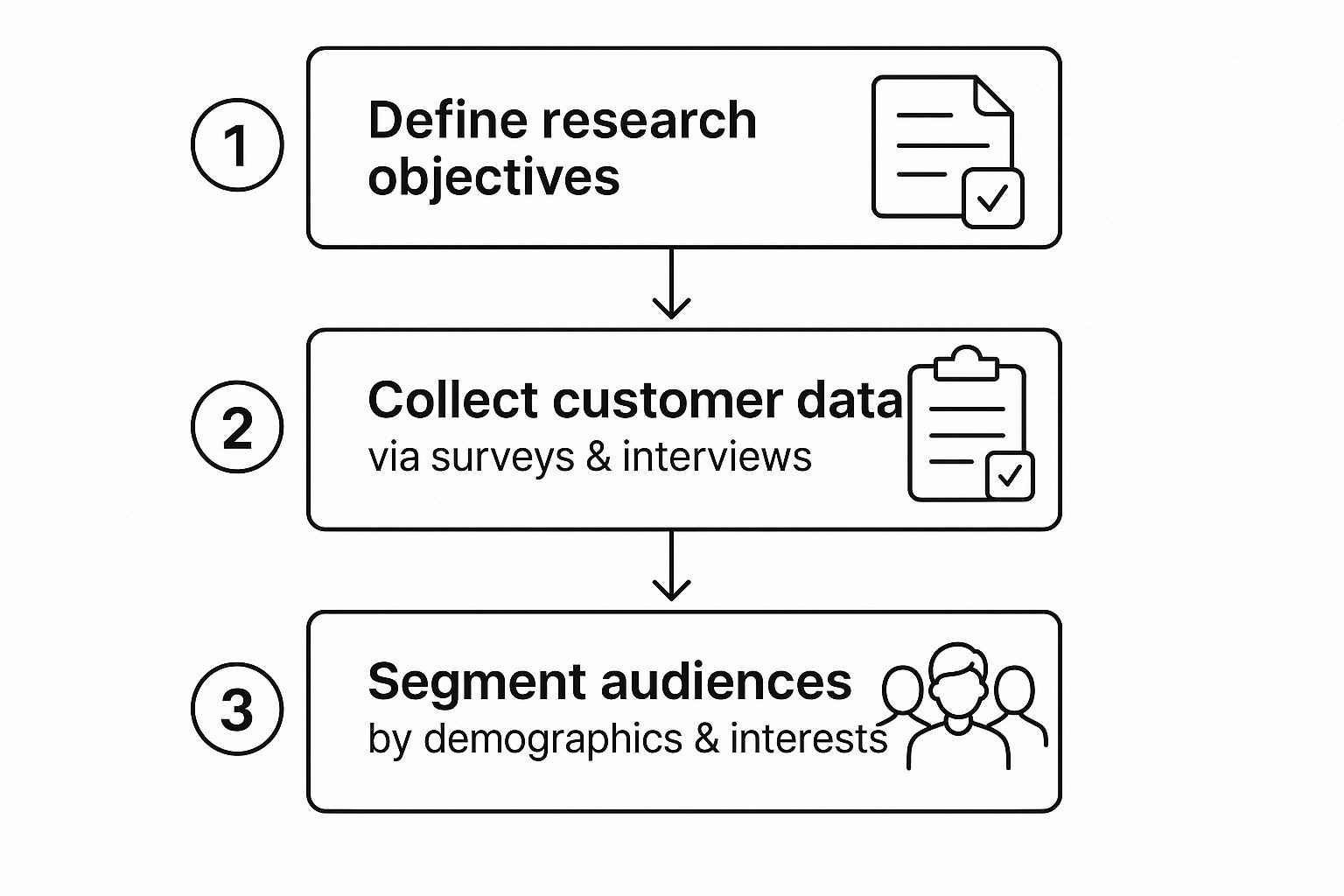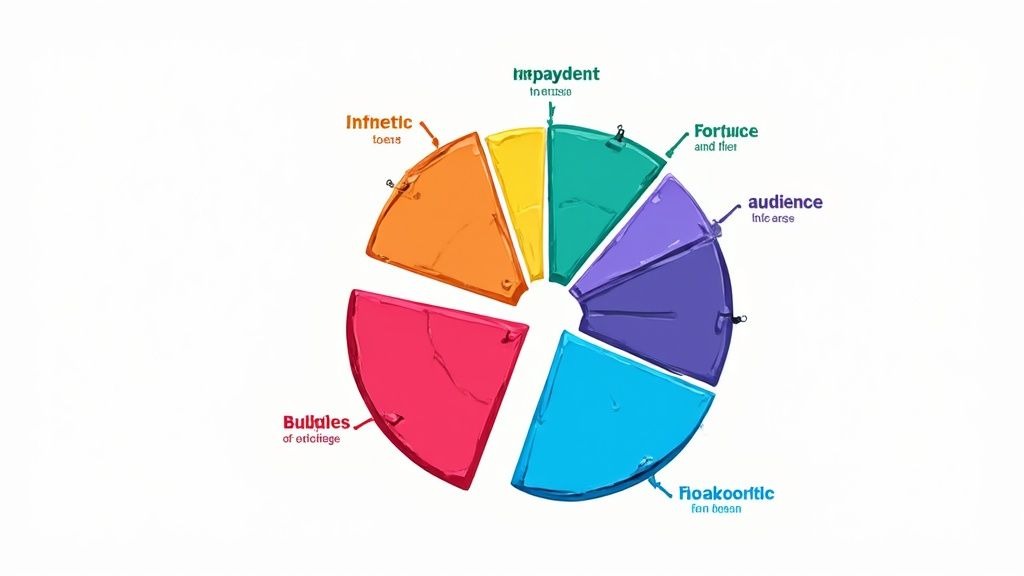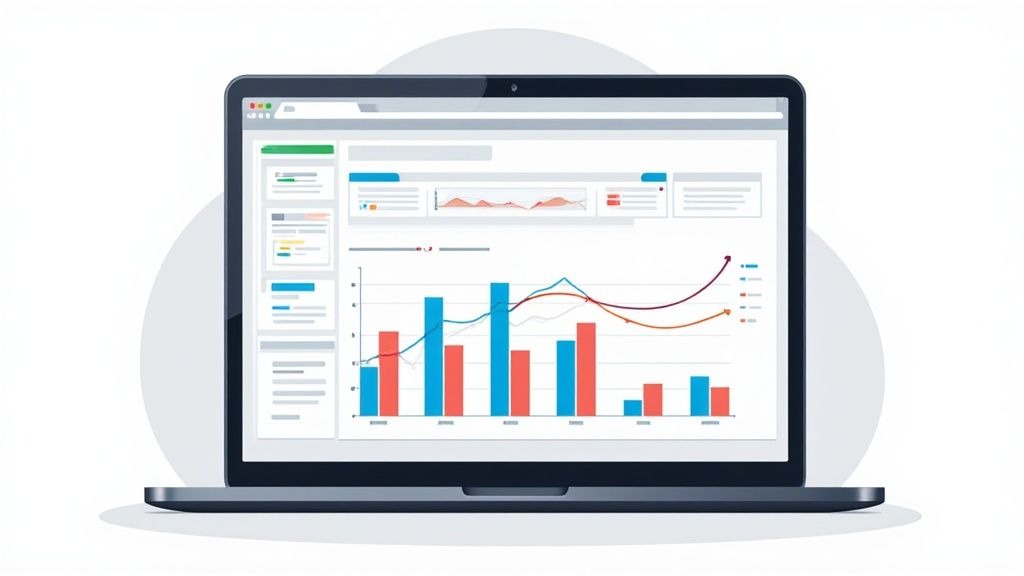To get your B2B podcast off the ground, the very first thing you need to nail down is your target audience. But I'm not talking about chasing massive download numbers. The real win is connecting with a niche group of people who can actually become customers.
This means aligning your podcast's audience with your Ideal Customer Persona (ICP). It’s the most critical step, and getting it right changes everything.
Why Your Podcast Needs an ICP, Not Just an Audience
The old wisdom of "casting a wide net" is a death trap for B2B podcasts. What’s the point of attracting thousands of casual listeners who will never, ever buy from you? It’s a huge waste of time, energy, and money.
The real value comes from crafting content for a smaller, highly engaged group of people who perfectly match your Ideal Customer Persona.
When you make this shift, your podcast stops being just another content marketing channel. It becomes a powerful, predictable engine for business growth.

From Broad Appeal to Business Impact
When you know exactly who you’re talking to, their job title, their biggest headaches, what keeps them up at night, you can design every single episode to solve their specific problems. This builds incredible trust and positions your brand as an essential resource in their world.
Think of it this way: a generic marketing podcast might pull 50,000 downloads an episode. That sounds great, right?
But if your ICP is a Series B SaaS CMO, a hyper-specific show that only gets 500 downloads from those exact people is infinitely more valuable. Why? Because those 500 listeners are your future customers.
The goal isn't to be a popular podcaster; it's to be the only podcast your ideal customer feels they can't afford to miss. This focus is what turns listeners into qualified leads.
This laser-focused strategy gives you a few massive advantages:
- Higher Conversion Rates: When your content directly addresses the challenges of your ICP, those listeners are far more likely to check out your services. You've already proven you get them.
- Efficient Resource Allocation: You stop wasting effort creating content for an audience that will never convert. Every dollar and hour you invest in the podcast serves a clear business purpose.
- Stronger Brand Authority: By dominating a niche, you become the go-to expert. This reputation doesn't just attract listeners; it attracts high-value opportunities.
We can see the difference pretty clearly when we compare the two approaches.
General Audience vs ICP-Aligned Listener

This table makes it obvious. For B2B, one path is a vanity project, and the other is a strategic asset.
Ultimately, focusing on your ICP transforms your podcast from a nice-to-have into a machine that nurtures high-quality leads. To get a better handle on this, you can learn more about what lead qualification involves and see how a well-defined audience is the foundation of the whole process.
Every episode becomes an opportunity to guide potential customers one step closer to a conversation with your sales team.
Defining Your Listener Through Your Best Customers
The blueprint for your ideal podcast listener isn't some abstract concept you need to pull out of thin air. It already exists inside your business, hiding in plain sight.
Your most valuable, successful, and loyal customers are the perfect model for the audience you want to attract with your show.
Forget about inventing a fictional character from scratch. You can build a listener persona grounded in real-world data from the people who already love what you do. This ensures you're creating content for people who are actually potential customers, not just casual listeners. The trick is to look past simple revenue numbers and figure out who your best customers truly are.
Pinpointing Your Top Clients
First things first: make a list of your top 10-20 clients. While revenue is a good starting point, don't let it be the only factor. A truly great customer relationship is about so much more than the money they spend.
Think about these qualities when you're building your list:
- Partnership Quality: Who do you genuinely enjoy working with? These are the clients who give the best feedback and become your biggest advocates.
- Low Friction: Which accounts require the least amount of hand-holding? They just get your value proposition on a deeper level.
- Loyalty and Advocacy: Who refers other businesses to you or leaves glowing testimonials without even being asked? Their enthusiasm is a massive signal.
- Product/Service Alignment: Which clients use your product exactly as you intended and get the most value from it?
Once you have this list, you've essentially mapped the DNA of your ideal listener. This isn't just a content exercise; it's a core component of customer-led growth for B2B podcasting because it ties your show directly to business outcomes.
Mining Internal Knowledge for Rich Data
Your sales and customer success teams are sitting on a goldmine of information. They talk to your ideal customers every single day and have a real, boots-on-the-ground understanding of their world. You need to tap into that.
Set up some time to interview them and dig into the specifics of the clients you just identified.

The goal here is simple: gather real customer data through direct interaction to figure out who you should be talking to on your podcast.
During these internal chats, push for concrete answers to questions like these:
- What are their real job titles? Not the fancy, inflated ones, but what they actually do.
- What are their biggest challenges and frustrations at work? What keeps them up at night?
- What are their personal career goals and aspirations? What does success look like for them?
- What specific language, jargon, and acronyms do they use all the time?
By documenting the exact phrases and terminology your best customers use, you gain the ability to speak their language authentically. This is how you create podcast content that makes your ideal listener feel like you're reading their mind.
This whole process moves you way beyond generic demographic data. You're digging into the psychographics that truly drive people to listen and engage. You’re not just defining an audience; you’re building a detailed profile of a future customer who is ready to listen, learn, and, eventually, buy.
Validating Your Persona with Real-World Research
Basing your listener persona on your best customers is a brilliant first move. It gives you a strong, data-backed hypothesis of who you should be talking to. But let's be honest, right now it's still just that, a hypothesis. It’s built on your own internal data and assumptions.
The crucial next step is to get out of your own building (metaphorically speaking) and see if your theory holds up in the wild. You have to validate it with external, real-world research.
This doesn't mean you need to commission complex surveys or run a bunch of focus groups. It’s simpler than that. It’s about becoming a strategic observer. Your job is to find your ideal listeners in their natural digital habitats and just… listen. Pay attention to the conversations they're already having.
This fly-on-the-wall approach gives you raw, unfiltered insights into their actual challenges, their real goals, and the specific language they use to talk about them.

Finding Your Persona in the Wild
Your ideal listener is already online, talking, networking, and, let's be real, venting. You just need to know where to look. Think about the platforms and communities where professionals in their role gather.
Here are a few prime locations to start your strategic listening tour:
- LinkedIn Groups: Search for groups related to your persona's industry, job title, or even the specific software they use day-to-day. If your ICP is a "Demand Generation Manager at a SaaS company," you should be lurking in groups dedicated to demand gen, B2B marketing, or specific marketing automation tools.
- Industry-Specific Forums: Don't sleep on old-school forums. Many niches have dedicated communities that are way less noisy than broad social platforms. These are often absolute goldmines for candid discussions about industry-specific headaches.
- Reddit Communities (Subreddits): Reddit can be an incredibly honest place. Subreddits like r/sales, r/marketing, or more niche communities like r/SaaS can offer a firehose of insights into their daily frustrations and wins.
This whole process is about gathering qualitative data, the 'why' behind the numbers. Analytics tell you what people do, but listening to their organic conversations tells you why they do it. If you want to dive deeper, check out our guide on the difference between qualitative vs. quantitative metrics to see why both are vital.
What to Listen For
Once you've found these communities, your mission is simple: observe and document. This is not the time to jump in and start promoting your podcast. Just watch. Listen. And take notes.
You're looking for patterns that answer these key questions:
- What questions pop up over and over again? Recurring questions are a huge tell. They signal common knowledge gaps and persistent problems, the perfect fuel for future episode topics.
- What are they complaining about? People love to vent about inefficient processes, clueless bosses, or software that doesn't deliver on its promises. These pain points are podcasting gold.
- What content do they share and praise? Pay attention to the articles, podcasts, and influencers they respect. This shows you what kind of content they already find valuable and who they trust.
- What jargon and acronyms do they use? Just like with your internal research, documenting their language is key. It helps you sound like an insider who gets it, not an outsider trying to sell something.
By immersing yourself in these communities, you make sure your podcast content isn't just relevant, but deeply resonant. You'll be tapping into the exact conversations your ideal listeners are already having, making your show feel like it was created just for them.
This external validation step is non-negotiable. It’s what bridges the gap between your internal assumptions and the market's reality. When you combine the data from your best customers with the unfiltered voice of your broader target audience, you create a persona that is both accurate and actionable.
That's how you set your podcast up for true strategic success.
Mapping Your Content to Solve Audience Pain Points
You've done the hard work and built a validated persona. The guesswork is over; you're now armed with data-backed insights into who you're actually talking to.
Now for the fun part: turning that deep understanding into podcast episodes your ideal listener can't afford to miss. This is where your research breathes life into your content strategy. We're shifting the focus from what you want to talk about to what your audience needs to hear.
The goal is simple: solve their problems, address their frustrations, and help them hit their goals. Do this consistently, and your podcast becomes more than a creative side project; it becomes a strategic asset that builds real authority and drives qualified interest.
From Pain Points to Content Pillars
Go back through all your research, the notes from sales calls, the screenshots from LinkedIn groups, and the recurring questions you found on Reddit. Start grouping all that raw data into three to five core themes. Think of these as your "content pillars."
These pillars represent the biggest challenges and aspirations your ideal customer persona is dealing with day-to-day.
Let's say your ICP is a Head of Marketing at a B2B SaaS startup. Your content pillars might look something like this:
- Demand Generation Tactics: All about practical, in-the-trenches strategies for pipeline growth.
- Marketing Leadership: Covering the messy human side of the job, team building, budget fights, and reporting up to the C-suite.
- MarTech Stack Optimization: How to squeeze every last drop of value from their expensive software stack.
These pillars give you a reliable framework. Instead of staring at a blank content calendar, wondering what to cover next week, you can just ask, "What specific problem within our 'Demand Generation' pillar can we solve in this episode?" This keeps every single piece of content you create laser-focused on your ideal listener.
Building your show around content pillars tied to audience pain points is the most reliable way to create a binge-worthy podcast. Your listeners will keep coming back because they know every episode offers a potential solution to a real-world problem they are currently facing.
Turning Real Questions into Compelling Episodes
Honestly, the best episode ideas aren't dreamed up in a boardroom. They're stolen directly from the communities where your audience is already hanging out. Strategic listening is like having a direct line into their private conversations. You get to see the exact language they use and the specific obstacles tripping them up right now.
This is how you build a powerful podcast content marketing engine that actually delivers results. Start thinking about how to turn those scattered discussion points into structured, high-value episodes.
For instance:
- A Recurring LinkedIn Question: You keep seeing people ask for advice on "calculating customer acquisition cost for a PLG model." Perfect. That’s an expert interview episode. Bring on a CFO or a battle-tested growth leader to break it all down.
- A Frustration from a Forum: You find a thread where everyone is complaining about how hard it is to align their sales and marketing teams. That could be a solo deep-dive episode where you walk through a step-by-step framework for building a solid service-level agreement (SLA).
This process ensures your content isn't just useful in a generic sense; it's timely, specific, and feels like you're reading their minds.
Validating Content Ideas with Social Data
You can also use platform data to gut-check your content ideas. For instance, knowing that Facebook is still a monster with 3.065 billion monthly active users and that the 25-34 age group is its largest demographic (31.1%) is a useful starting point.
If your ICP falls into that bucket and values customer care, a noted strength of the platform for Millennials and Gen X, you can validate your content pillars by seeing how similar topics perform in relevant Facebook Groups. Digging into these new social media demographics can give you that extra layer of confidence before you hit record.
How to Refine Your Audience Definition Over Time
Defining your target audience isn't a "set it and forget it" task; you can tick off a checklist. It’s a living, breathing part of your podcast strategy. As your business evolves and the market shifts, so will your ideal listener.
To keep your podcast sharp, you need a continuous feedback loop. Think of it as an ongoing conversation. This ensures your content never gets stale and always hits the mark with your Ideal Customer Persona (ICP).

You're always learning, always adapting. Your initial listener persona is just version 1.0. Your job is to keep gathering data to release versions 1.1, 1.2, and beyond, making small but powerful tweaks along the way.
Tapping into Listener Feedback
The most straightforward way to sharpen your focus? Just listen to the people who are already tuning in. Don't guess what they want; create easy ways for them to tell you.
- Mine your social media comments. When listeners pop up on your LinkedIn posts with follow-up questions, they’re handing you content ideas on a silver platter. Keep a running list of these questions. They directly point to the knowledge gaps and pain points you might be missing.
- Run simple in-episode polls. This doesn't need to be complicated. Mid-episode, ask a single question like, "What's the one tool you couldn't live without at work?" and link to a one-question survey in the show notes. The answers give you immediate, actionable intel.
Your podcast analytics are a direct line to what resonates. A sudden download spike on an episode about a super-niche topic is a clear signal from your audience to go deeper. It’s not just data; it’s a dialogue.
Using Performance Data to Guide Your Strategy
Beyond direct comments, your podcast's performance metrics are your source of truth. If you’re not regularly reviewing this data, you’re flying blind. Learning how to measure podcast performance is non-negotiable if you want the numbers to guide your content decisions.
Look for the patterns. Which topics consistently crush it? Maybe your deep-dive on "AI in Sales Prospecting" got double the downloads of a broader "Marketing Trends" episode. That’s a huge clue that your audience is hungry for specific, tactical advice.
This data tells you exactly what to double down on and what to dial back. It’s about understanding the digital world your listeners live in. As of early 2025, 5.56 billion people were using the internet, with 5.24 billion of them active on social media. Your potential audience is out there, and their listening habits are telling you exactly what they want. (You can dive into the latest global digital population stats from Statista for more context.)
When you combine this kind of qualitative feedback with hard, quantitative data, you turn audience research from a static task into a dynamic strategy. This constant process of refinement is what keeps your show a must-listen resource for your perfect customer.
Frequently Asked Questions
Even with the best game plan, a few questions always pop up when you're trying to pin down your B2B podcast audience. Getting this part right is a huge deal, so it's totally normal to want to nail it. Let's walk through some of the most common hurdles I see teams face.
What If My Business Has Multiple ICPs?
This comes up all the time, especially for companies with different products or service tiers. The answer is simple, but it can feel tough: choose just one ICP for your podcast. At least for now.
When you try to make content for a bunch of different people at once, you end up with a show that's too generic and doesn't truly connect with anyone. It's a recipe for a forgettable podcast.
So, how do you pick? Look for the biggest growth opportunity. Ask your team, "If we could capture the attention of one customer segment, which one would absolutely move the needle for our business?" Start there. Once you've built a successful show, you can always spin up another one for a different audience down the line.
How Niche Is Too Niche For A Podcast Audience?
Honestly, for a B2B podcast, it’s almost impossible to be too niche.
That laser-focused, hyper-specific approach is your superpower. If you’re starting to worry that your potential audience feels too small, you're probably on the perfect track.
Remember what we're doing here. The goal isn't to rack up millions of downloads like a mainstream hit. The goal is to become the only podcast that a small, incredibly valuable group of future customers feels they have to listen to. A show for "VPs of Engineering in the FinTech space" is way more powerful than one for "all tech leaders." The tighter your focus, the more your ideal listener will feel like you made the show just for them.
Don’t be afraid of a small audience. A podcast with 500 downloads from your exact ICP is infinitely more valuable than a show with 50,000 downloads from a general audience who will never become customers.
This focused approach is fundamental. If you're just getting started, our complete guide on how to start a B2B podcast walks through this and other foundational steps.
How Long Should I Spend On Audience Research?
While there isn't a magic number of hours, this is something you need to block out serious time for. We're talking days, not a few hours squeezed between meetings. The work you do now, defining your ICP, talking to your internal teams, and validating it all externally, is the most important part of this entire process.
As a rule of thumb, plan to spend at least 15-20 hours on this foundational research before you even start dreaming up episode topics or designing cover art.
If you rush this stage, you'll pay for it later. It's far more expensive to fix a show that's missing the mark than it is to get it right from the beginning. Nail this, and everything else that comes after gets a whole lot easier.
Ready to build a podcast that attracts your ideal customers? Fame is the B2B podcast production agency that turns your expertise into a pipeline-driving machine. Learn more at https://www.fame.so.

